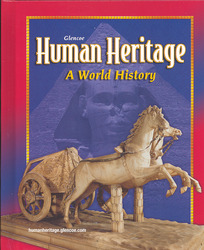Human Heritage: A World HistoryChapter 37:
Conflict and ChangeWeb Activity Lesson Plans“Media Mission”Introduction
Students have read about U.S. involvement in World War II. In this exercise, students will examine the posters used during World War II that communicated the need for Americans to support the war effort. Lesson Description
Students will use information from the National Museum of American History Web site to learn about the use of posters in encouraging patriotism during World War II. Students will see posters from the war era and read about the ideas the posters conveyed. They will also read about why posters were used and how they changed the ways that labor and management worked. Students will then answer four questions and apply this information by writing an essay describing their ideas on how effective a poster campaign would be today. Instruction Objectives
- Students will be able to explain how the use of posters affected American support of World War II.
- Students will be able to use this knowledge to write an essay describing the effectiveness of a poster campaign in America today.
Student Web Activity Answers
- The posters of World War II tried to unite Americans in supporting the war effort. Citizens were encouraged to participate in any way possible—growing, conserving, saving, and producing. Posters aimed to sell the idea that increased production in factories helped to fight the war. Also, the posters tried to make the war personal by raising the possibility that it could happen on American soil.
- Posters were a popular method of communication because they had democratic appeal, in that they were easy to make, hang, and read. Posters could be hung everywhere—in schools, factories, offices, stores—and people encountered them wherever they went.
- During the 1930s, labor and management had gone through an era of violent disputes. Posters tried to send the message that wartime was a time to put away old resentments and work together. Workers were encouraged to make personal sacrifices, suspend union rules, and produce as much as possible in the patriotic effort. Posters convinced workers that they were "production soldiers." Meanwhile, management was able to gain more control over the labor force.
- "Beat the promise" referred to production quotas. The slogan encouraged workers to produce more than the day's quotas, in the name of patriotism.
- Students' essays will vary.
 | 




